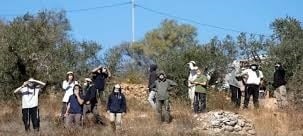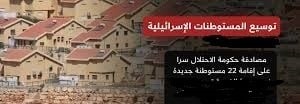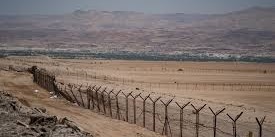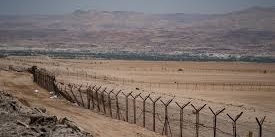By: Madeeha Al-A’raj
The National Bureau for Defending Land and Resisting Settlements stated in its latest weekly report , that over the years, the olive tree has become a national symbol for Palestinians, and a universal symbol for peace, to which they repeat their popular proverbs and songs, especially during the olive harvest season, which begins in mid-Oct. of each year until the end of November and more. We, the Palestinians eagerly await the harvest season, celebrating with joy and eagerness the season. We have woven an emotional relationship with this tree, as one can see us in the fields extending across the mountains, plains and valleys, in groups and individuals. Thefields are adorned with a new look that reflects a joyful popular character that is full of life and belonging.
The Palestinians are proud of their olives, and their oil is the best in the world. It is futile to argue with Palestinians about their belonging to this tree or the quality of its oil. One of their famous proverbs in this regard is, “Wheat and Oil are Two Precious Treasures at Home.” One of the manifestations of Palestinian pride in their olive trees is their story about the oldest olive tree in the history of agricultural civilization. It is located in the Al-Walaja Village, Bethlehem, near the Apartheid Wall. Its age is estimated by experts from the UNESCO, about 5,500 years. It is about 12 meters high, and 25meters in diameter, and has 22 branches, each branch like a tree. It covers an area of 250m2, and annually produces about 500 kg of seeds in good seasons.
Over the years, to protect the land from the monster of settlement and the occupation policy in general, the Palestinians began to expand the cultivation of the olive tree, especially in recent years after the Al-Aqsa Intifada i.e. the “II Intifada”. The area of land planted with olives in 2010 was about 462,824 dunams, of which about 21,509 were in the Gaza Strip, and in 2021 it became about 575,194 dunams, of which 33,633 were in the Gaza Strip. Thus, the olive tree entered the dictionary of popular resistance to defend the land and resist settlement.
One of the responses by the Palestinians to the Israeli occupation state’s settlement expansion in the Palestinian countryside, especially in the areas classified according to the agreements signed between the Palestinian and Israeli parties as Area C, was the expansion of olive tree cultivation, which has become a symbol of defiance and steadfastness on the one hand, and a target of the occupation policy and the settlement monster on the other hand. It was treated with sabotage, cutting and fires in a joint aggression between the occupation army and settler gangs, until the number of trees that were sabotaged, cut and burned by the occupation and its settlers were 278.000 and more since 2012, especially in the areas located behind the Apartheid Wall and settlements.
The annual production rate of olive oil in the West Bank is estimated at about 5,500 tons for Jenin Governorate, followed by Tulkarm at 3,500 tons, then Nablus, Ramallah, Salfiee and the Gaza Strip at 3,000 tons each, Qalqilya at 1,500 tons, Hebron at 1,000 tons, Bethlehem at 600 tons, and Jerusalem at about 200 tons, while the production of olive oil in Jericho Governorate is almost limited.
The olive tree has become a main target by the occupying state’s polices in particular, and its settlers in general, but after Oct. 7, it has become an integral part of the brutal war waged by the occupying state on the Gaza Strip as well as the West Bank, including Jerusalem. In the Gaza Strip, the war had devastating effects on the olive sector, as the war destroyed more than 75% of the olive trees in the Strip, and the residents of the Strip were not able to reach some of their fields except during the days of the temporary truce that lasted for 7 days in November, when they picked the olives from their lands that were not affected by the Israeli bulldozing and destruction.
Last year’s season in the West Bank was extremely tough for farmers after the occupation authorities imposed military rule on the West Bank and closed off large areas of the countryside to citizens with military checkpoints and earth mounds. The checkpoints and military gates between cities in the various governorates returned in a worse and harsher way than they were during the II Intifada, and the earth mounds hindered farmers’ ability to reach their fields.
In many villages, especially those adjacent to the Aparthied Wall and settlements and outposts, the earth mounds can be seen only 200 meters away from residential buildings, and anyone who dared to cross them will find himself in direct confrontation with the emergency teams, which Ben Gvir has established as a private militia in his ministry to terrorize citizens, and in direct confrontation with the thugs of the Hilltop Youth.
In previous years, the occupation authorities granted citizens, through coordination, military permits allowing them to access their lands in certain areas, such as, those located behind the wall ‘69 gates’ or lands adjacent to settlements ‘more than 110 towns, villages and communities whose lands are located adjacent to 56 settlements and dozens of settlement outposts’.
In the 2023’s olive harvest season, the occupation authorities cancelled almost all of these permits, effectively preventing farmers from accessing their lands. The agricultural gates along the Apartheid Wall remained closed, while the lands adjacent to the settlements were mostly closed by the occupation forces with earth mounds. Identical estimates from more than one source indicate that more than 96,000 dunams of olive-planted land throughout the West Bank were included in the occupation’s instructions as closed military areas, which resulted in the loss of a large olive crop.
Settlers practiced various forms of violence against Palestinian citizens to prevent them from picking their olives. The OCHA documented 113 incidents of settler attacks between Sep. – Nov. of last year, ranging from attacks on Palestinians to damage to their trees or theft of their crops and harvesting tools. Of these incidents, 10 resulted in injuries and property damage, 10 resulted in injuries but no property damage, and 93 resulted in damage but no injuries.More than 2,000 trees were vandalized during these incidents, with the highest number of incidents in the governorates of Nablus ‘40\ and Ramallah ‘31’. The aforementioned office estimated that more than 10,000 olive trees were vandalized by settlers throughout the West Bank in 2023.
Atleast 38 of the incidents, Palestinian farmers or other eyewitnesses reported that the occupation forces accompanied the attackers or that the attackers were wearing military uniforms while expelling Palestinians from their agricultural lands and seizing their olives and tools. Nearlyhalf of the incidents \46%’, Israeli security forces were present at the time of the incident, but instead of protecting the Palestinian pickers as required by their duty, they expelled the farmers and prevented them from picking the olives.
This year’s season is more severe for farmers than last year, threatening more and more r crop losses, wherever you go in the villages adjacent to the Apartheid Wall and settlements, you will find Ben-Gvir’s emergency teams and Hilltop Youths confronting you. The settlers’ terror, under the protection of the occupation army and the participation of Ben Gvir’s militias in attacking citizens during the olive harvest season, began early this year, starting with preventing farmers from reaching their fields, robbing the crop, burning olive trees, and shooting farmers, as is the case in Hizma and Jaba’ in the Jerusalem Governorate, and in Al-Lubban Al-Gharbiya, Barqa, Beitin, Turmusaya, and Al-Mughayyir in the Ramallah and Al-Bireh Governorate, Sebastbeh, Hawara, Burin, Madama, Deir Sharaf, Qasra, Beit Furik, Tal, Asira Al-Shamaliya, Jalud, and Qaryut in the Nablus Governorate, Jama’in and Yasuf in the Salfeet Governorate, Azzun, Kafr Laqif, and Kafr Thulth in the Qalqilya Governorate, Ramin and Kafr Al-Labad in the Tulkarm Governorate, Husan in the Bethlehem Governorate, Dura in the Hebron Governorate, and Faqqu’a in the Jenin Governorate, where citizen Hanan Abu Salama , 59 was martyred a few days ago by the bullets of the occupation army and Ben Gvir’s militia, in addition to expectations that farmers will not be able to reach 80,000 dunums of land planted with olives due to the practices of the army, and occupation and settler terrorism, which could lead to the loss of about 15% of this year’s crop.
The new in this regard is that with the escalation of settler violence in the West Bank, the central unit of the Israeli police under the command of Afshai Moalem, a close associate of Ben Gvir, has stopped coordinating with the Shin Bet to limit, even on a limited scale of settler attacks. Moalem was promoted to this position a year ago, and is now a candidate by Minister Ben Gvir to be promoted to the rank of captain to be head of the intelligence division in the Investigations and Intelligence Administration, which is considered a senior position in the police force.
In light of the cessation of coordination by the central unit of the Israeli police in the occupied West Bank with the division responsible for Jewish terrorism in the Israeli General Security Service ;Shin Bet’, according to what the Haaretz newspaper revealed last Sunday, settler attacks and assaults targeting Palestinians in the West Bank are escalating, under the cover of the war on Gaza. The newspaper added that Shin Bet officials confirmed in closed conversations that the police unit is not doing its duty in dealing with the manifestations of violence and terrorism committed by settlers and extreme right-wing elements against Palestinians in the West Bank.
According to its report, the unit commander, Moalem, originally denies the increase in Jewish terrorism in the West Bank and refrains from coordinating with the relevant agencies. Haaretz continues that the central police unit in the West Bank, known as the “Shai” police ‘an acronym for Judea and Samaria in Hebrew – the Israeli name for the West Bank;, has worked over the years in coordination with the Jewish division of the Shin Bet. The division provided the unit with intelligence information about Jewish terrorist activities in the West Bank. All of this stopped on the instructions of Itamar Ben-Gvir, who last week demanded that Netanyahu not allow Palestinians to access their lands in the West Bank during the olive harvest season, which even prompted the German Ambassador to Israel, Stefan Seibert, to demand that Netanyahu reject Ben-Gvir’s request and protect Palestinian farmers on their lands from settler attacks.
With regard to the settlement, the so-called Israel Lands Authority published a tender last week to build 286 housing units in an open area north of the Ramat Shlomo settlement in East Jerusalem that was seized through the application of the Absentee Property Law, according to a statement issued by the Israeli Ir Amim Asociation. This is part of a plan to build a total of 650 units on an area of 71 dunams, which would expand Ramat Shlomo towards the Palestinian neighborhood of Beit Hanina.
The tender is scheduled to open for bidding on Nov. 20, 2024, but the Israel Lands Authority could decide to postpone the process. This plan would expand the aforementioned settlement northward, to the edge of the built-up area of the Beit Hanina Neighborhood, and achieve two goals of Israeli policy in East Jerusalem, first, complicating the possibility of drawing the future borders of the Palestinian capital in Jerusalem, and second, preventing the ability of Palestinian neighborhoods to expand and develop to meet the needs of their residents.
At the same time, the occupation authorities and the settlement organizations are expanding the establishment of more settlement outposts under wartime conditions. 43 illegal settlement outposts have been established since the beginning of the war. For comparison, the settlers used to establish an average of about 6 settlement outposts per year. While in the war year, they established an outpost almost every week. ThOse settlement outposts are, according to estimates by Israeli organizations opposed to settlements, linked by an umbilical cord to settler violence and the expulsion of Palestinian shepherds and farmers from their lands, a phenomenon that the head of the Shin Bet considers ;Jewish terrorism’, despite the war, the army recruited settlers to guard the settlements and outposts, while Minister Itamar Ben Gvir made distributed weapons to them.
List of Israeli Assaults over the Last Week Documented by the National Bureau:
Jerusalem:
- Bulldozing land, demolished water lines, a fence, and a number of plants owned by citizen Marwan Darbas in the Issawiya town.
- Demolishinga facility for selling and filling medical oxygen, owned by the Badriya family in the industrial zone of Wadi al-Joz. The demolition comes within the framework of the plan to implement the ‘Silicon Valley project’, which threatens to demolish industrial and commercial facilities with the aim of building a technological zone ‘high-tech companies’, hotels and commercial spaces.
Hebron:
- Bulldozing more than 10 dunums of citizens’ lands planted with vegetables and fruit trees in the Beit Ummar town, in the “Al-Qarn” area southeast of the town, causing heavy losses.
- Preventing farmers from reaching their lands and picking olives in the ‘Khallet Taha’ and ‘Al-Abed’ areas in the Dura town.
Bethlehem:
- Attacking the home of Nader Abu Kamel in the village of Khalayel al-Loz, southeast of Bethlehem, smashed its doors and windows, and raised the flags of the occupying state around the house. They also cut down 20 olive trees.
- Bulldozing agricultural lands in the Battir town with the aim of expanding the borders of a settlement outpost there. Settlers and occupation soldiers also attacked shepherds while they were grazing their sheep in lands near the ;Tekoa settlement’, and fired sound bombs and toxic gas at them, and assaulted them.
Ramallah:
- Attacking olive pickers in the villages of Al-Mughayyir and Turmusaya, in an attempt to prevent them from picking olives, forced them to leave their lands.
- Shooting a young man in the foot with live ammunition during a settler attack on the Burqa village, east of Ramallah.
Nablus:
- Attacking olive pickers in the Shaab al-Kharab area in Qusra, and demanded that they evacuate the area, under gunpoint and by firing tear gas. The occupation forces assaulted olive pickers in the town of Asira al-Shamaliya, and seized the olive crop in the ‘Barnat area’ on the eastern side of the town. Settlers attacked olive pickers in the village of Jalud and forced them to leave their lands.
- Assaulting citizens while they were picking olives on the western side of the Guma village. The occupation forces expelled olive pickers from their lands in the village of Madama, south of Nablus, and attacked them with tear gas bombs. They forcibly forced them to leave their fields.
- Forcing Palestinian farmers to leave their lands while they were picking olives in the fields located on the western side of the Beit Furik town, threatening to arrest them if they returned to continue their work. The occupation forces expelled farmers and prevented them from picking olives in the western part of the village of Yanun, and detained a group of olive pickers in Burin, south of Nablus, while they were working on one of the lands classified as area ‘B’.
- Assaulting citizens while they were picking olives in the village of Rojib, where the settlers attacked the farmers, sprayed them with pepper gas, and forced them to leave the olive fields.
Salfeet:
- Attacking citizens’ vehicles between the towns of Rafat and Deir Ballut, west of Saleeit, under the protection of occupation soldiers.
- Chopping olive trees in the Wadi area, north of the village of Yasuf, in the village of Kafr ad-Dik, the occupation forces demolished the house of citizen Samih al-Natour, which was under construction, under the pretext of building in the so-called area ‘C’. In Deir Ballut, the occupation army uprooted olive seedlings, demolished a fence, and expelled olive pickers from their lands.
- Expelling farmers from their lands while picking olive trees in the Haris villager, injured farmer, Saif Suhail Khader Hussein, in the head after settlers from the Tafuh settlement, built on citizens’ lands in the Al-Mushrifa area, west of the village, attacked him while picking olives in the Yasuf village.
Jenin:
- Killing martyrdom Hanan Abdul Rahman Abu Salama, 59 after being shot by the occupation forces in the village of Faqqu’a, while she was picking olives with her family in the area near the racist Aparthied Wall built on the village’s lands. Settlers from the ‘Homesh settlement’ cut down dozens of olive trees in the town of Jaba’, while the occupation forces demolished 3 greenhouses in the Jalameh village, northeast of Jenin, in the village’s plain area, erected on an area of 3 dunams, belonging to the brothers Amjad and Hisham Nader Abu Farha.
Tulkarm:
- Preventing farmers in the Ramin village from picking olives and forced them to leave their lands at gunpoint. They threatened them not to return to their lands unless they obtained coordination and permits, under the pretext that the area is military. They also confiscated a tractor in the Ramin Plain owned by citizen Fayez Ahmed Fawzi Salman.
- Shooting against the participants in an event organized by the Wall and Settlement Resistan7ce Commission to help farmers from the village of Kafr al-Labad pick their olives from their lands.
Jordan Valley:
- Paving a settlement road in the northern Jordan Valley, southeast of the village of Kardala. It is expected to reach the outskirts of Khirbet Ibziq, and it covers large areas of land, part of which is owned by citizens, and the other part is mountainous pastoral land. Rehabilitating the road leading to the new settlement outpost with the aim of displacing the residents of the community.
- Storming the Arab al-Malihat community northwest of Jericho, roamed and searched some of the citizens’ homes, and placed signs on some of them as a warning of imminent danger.
 المكتب الوطني للدفاع عن الارض ومقاومة الاستيطان منظمة التحرير الفلسطينية
المكتب الوطني للدفاع عن الارض ومقاومة الاستيطان منظمة التحرير الفلسطينية




